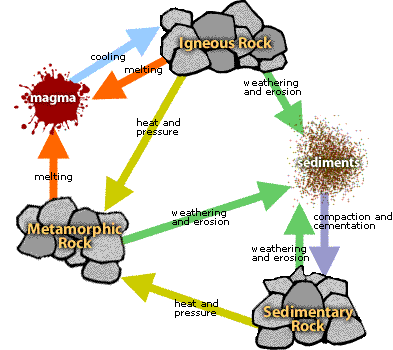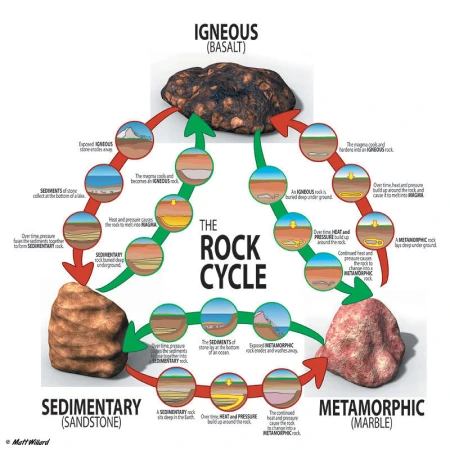The Rock Cycle
This blog is here to tell all about the rock cycle.
The following diagram is one way to look at the rock cycle.
Why is the rock cycle called, a rock cycle?
A circle is never ending; like the rock cycle. It also is continuous, it doesn’t stop and start up again. Every step in the rock cycle is happening right now, somewhere in the world.
What are the major components of the rock cycle?
The rock cycle is based on the 3 major rock groups: igneous, metamorphic, and sedimentary.
Following this a couple of examples for each group:
Igneous: Basalt Obsidian
Sedimentary: Sandstone Limestone
Metamorphic: Marble Granite
Rocks are classified in each of the categories by how they form.
- Igneous rocks form from lava or magma, or molten rock. When the molten rock melts, it forms rocks.
- Metamorphic rocks form from great pressure and great heat inside the earth. This chemically changes rocks into different rocks.
- Sedimentary rocks form from weathered sediments, when they are compacted and squeezed to make a rock. This creates layered rocks.
The rock cycle can be described as dynamic.
Why is it important that we learn about the rock cycle?
It is important because it is a vital part of how the earth is changing constantly and dynamically.
One way to think of the rock cycle is that the rocks are recycling themselves.
Here is the path of one rock.
1. We start in the middle of the earth, in the mantle as magma.
2. We are then shoved to the surface via a volcano as lava.
– When we cool, we are now an igneous rock, basalt.
3. We are slowly weathered down to smaller and smaller parts.
4. Some of our parts wind up at the bottom of a lake.
5. Over time, with pressure, we compress with our friends (other sediments).
-We are now a layered sedimentary rock, sandstone.
6. We are pushed down into the earths crust after layer after layer of rock covers us.
7. As we are pushed down, heat and pressure increase.
8. The continued pressure transforms the rock.
-We are now a metamorphic rock, marble.
Repeat ∞ times.
*NOTE: The rock cycle does not necessarily go in this order, or start inside the crust. For example, a piece of rock can be compressed and weathered down ∞ times. It doesn’t have to go Igneous→Sedimentary→Metamorphic. It could go Sedimentary→Sedimentary→Sedimentary→Sedimentary.
The rock cycle in a nutshell.
This entry was posted on April 4, 2011 at 11:39 pm and is filed under Uncategorized with tags cycle, metamorphic, project, rock, rock cycle, sedimentary. You can follow any responses to this entry through the RSS 2.0 feed. You can leave a response, or trackback from your own site.


April 25, 2011 at 9:14 pm
Nice Trent! And Ms. Dickerman, if you read this, hi from Robert. Anyway, great job Trent! Bye!
May 3, 2013 at 2:02 am
Awsome Thanks!
August 2, 2013 at 7:31 pm
Awesome article.